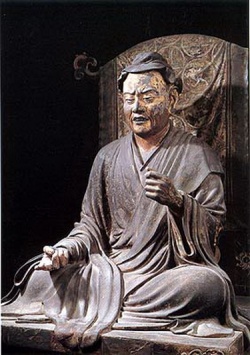Difference between revisions of "Vimalakīrti"
(Created page with "thumb|250px| Vimalakīrti is the central figure in the Buddhist Vimalakīrti Nirdeśa Sūtra,[1] which presents him as the ideal Mahayanist[2] lay...") |
|||
| Line 1: | Line 1: | ||
[[File:Vimalakirti1.jpg|thumb|250px|]] | [[File:Vimalakirti1.jpg|thumb|250px|]] | ||
| − | Vimalakīrti is the central figure in the Buddhist Vimalakīrti Nirdeśa Sūtra,[1] which presents him as the ideal Mahayanist[2] lay practitioner[3] and a contemporary of Gautama Buddha (6th to 5th century BCE).[1] There is no mention of him in Buddhist texts until after Nāgārjuna (1st century BCE to 2nd century CE) revived the Mahāyāna teachings in India. | + | Vimalakīrti is the central figure in the Buddhist Vimalakīrti Nirdeśa [[Sūtra]],[1] which presents him as the ideal Mahayanist[2] lay practitioner[3] and a contemporary of [[Gautama Buddha]] (6th to 5th century BCE).[1] There is no mention of him in [[Buddhist texts]] until after [[Nāgārjuna]] (1st century BCE to 2nd century CE) revived the [[Mahāyāna]] teachings in [[India]]. |
| − | Translator Burton Watson argues that the Vimalakirti Sutra was likely composed in India in approximately 100 CE.[4] It was translated into Chinese several times,[5] first in approximately 180 CE. Two especially influential translations are the Kumārajīva version (406 CE), which is the most widely used[5] and the Xuanzang version (650 CE).[5] Chos-nyid-tshul-khrims also translated it into Tibetan in the 9th century. Most Japanese versions are based on the Chinese Kumarajiva version.[5] The original Sanskrit text is lost, and only fragments remain in certain Mahayana texts. | + | Translator Burton Watson argues that the [[Vimalakirti Sutra]] was likely composed in [[India]] in approximately 100 CE.[4] It was translated into Chinese several times,[5] first in approximately 180 CE. Two especially influential translations are the [[Kumārajīva]] version (406 CE), which is the most widely used[5] and the [[Xuanzang]] version (650 CE).[5] Chos-nyid-tshul-khrims also translated it into Tibetan in the 9th century. Most Japanese versions are based on the Chinese Kumarajiva version.[5] The original [[Sanskrit]] text is lost, and only fragments remain in certain [[Mahayana]] texts. |
{{W}} | {{W}} | ||
[[Category:Buddhist Terms]] | [[Category:Buddhist Terms]] | ||
[[Category:Vimalakirti]] | [[Category:Vimalakirti]] | ||
Revision as of 10:44, 29 April 2013
Vimalakīrti is the central figure in the Buddhist Vimalakīrti Nirdeśa Sūtra,[1] which presents him as the ideal Mahayanist[2] lay practitioner[3] and a contemporary of Gautama Buddha (6th to 5th century BCE).[1] There is no mention of him in Buddhist texts until after Nāgārjuna (1st century BCE to 2nd century CE) revived the Mahāyāna teachings in India.
Translator Burton Watson argues that the Vimalakirti Sutra was likely composed in India in approximately 100 CE.[4] It was translated into Chinese several times,[5] first in approximately 180 CE. Two especially influential translations are the Kumārajīva version (406 CE), which is the most widely used[5] and the Xuanzang version (650 CE).[5] Chos-nyid-tshul-khrims also translated it into Tibetan in the 9th century. Most Japanese versions are based on the Chinese Kumarajiva version.[5] The original Sanskrit text is lost, and only fragments remain in certain Mahayana texts.
